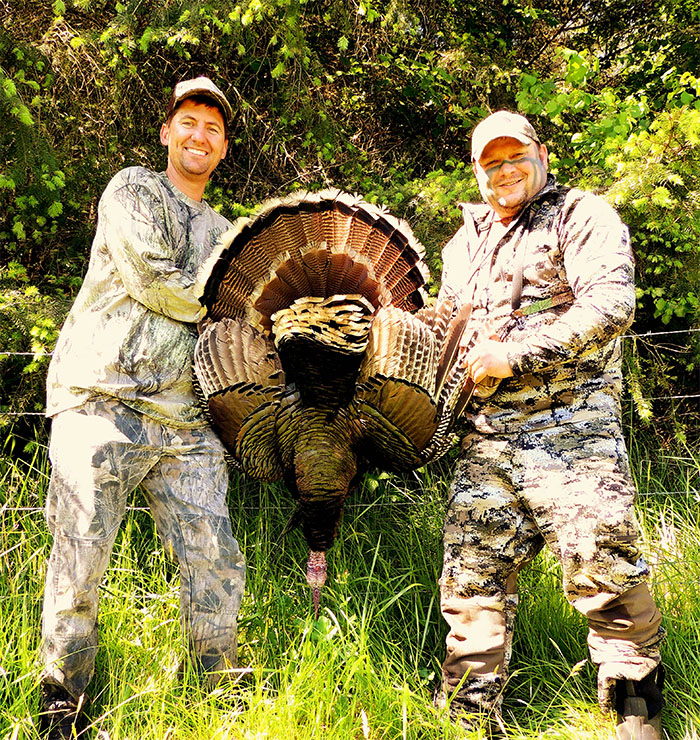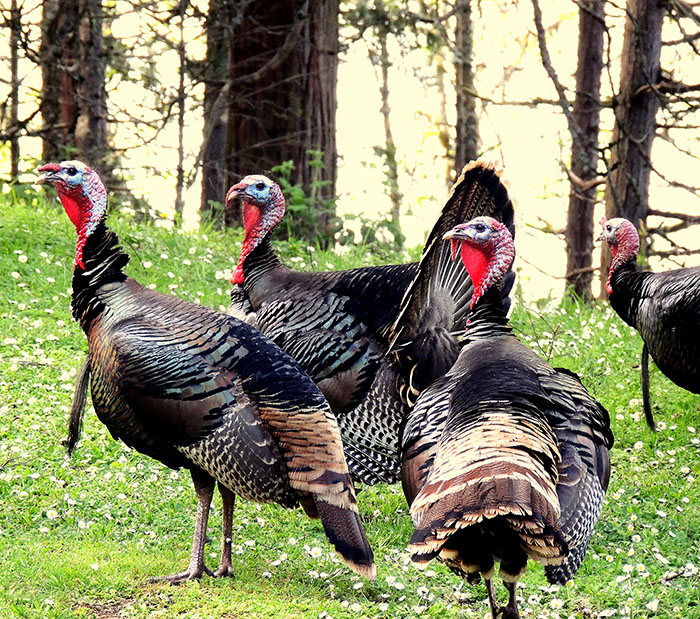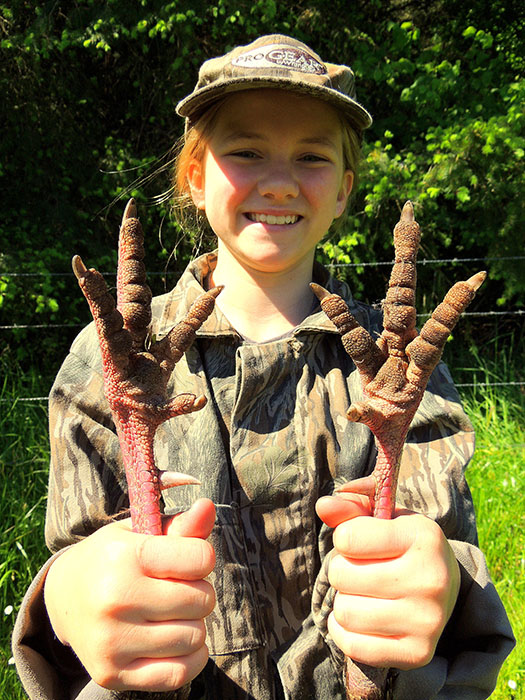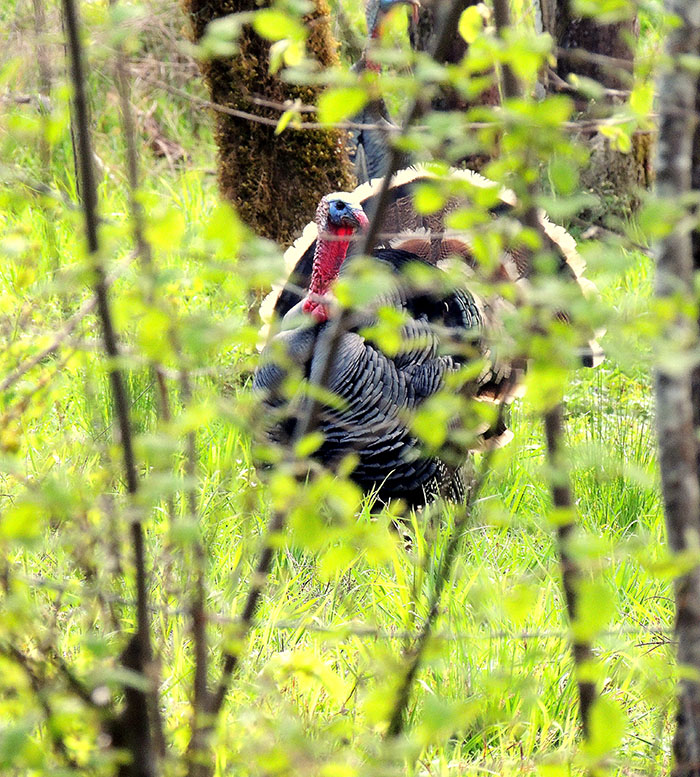2018 Pacific Northwest Turkey Outlook Leave a reply

The author (right ) called this big 21 lb. Boss Tom in for a friend last season. Curiosity and loneliness around mid morning once the hens had went to nest brought this guy into 18 yards. (Troy Rodakowski)
By Troy Rodakowski
I’m going to go out on a limb here! No pun intended but I’m going to go ahead and say that the 2018 Oregon spring turkey season will be fantastic! Why will it be fantastic might you ask?
First of all, last year’s dry spring and mild winter made for a great hatch and good poult survival. Secondly, we have had a fairly mild winter with less snow pack in many portions of the Pacific Northwest equating to less winter die off of birds. Yes, some of the late cold and snowy weather took its toll on some flocks but for the most part they are doing better than ever.
Good Bets: In order to find a gobbler this spring a hunter should be prepared to look higher in elevation. Lack of snow pack in many locations has enabled birds to disperse quicker into the high country. This spring will be similar to last year in many ways and hunters should keep in mind where they found birds last year and begin their searches in those areas. Turkey are drawn to food around small creeks with fresh vegetation, newly hatched insects, snails and small amphibians which are all irresistible to them. If you walk ridges above draws with creek bottoms that have freshly sprouted plant life you will eventually run into turkeys.
Turkey populations continue to expand throughout the Pacific Northwest as birds continue to do well and thrive in many locations. Now is the time to get involved and become a part of this exciting sport throughout our region. If you haven’t been turkey hunting yet I highly recommend giving it a try because the prospects for the 2018 season are looking pretty darn good.

A group of mature gobblers in search of a lonely hen. Often times during the early season birds will be found in larger groups with multiple gobblers hanging together. (Troy Rodakowski)
Western Oregon: Last season 13,716 hunters managed to harvest 5,246 birds during the spring season in the Beaver state. The top five units on the west side were the Melrose, Rogue, Willamette, Evans Creek and the Applegate. All of these units had good  harvests with some of the highest harvests coming from Melrose and Rogue followed by Evans Creek & Willamette respectively. Many of these birds congregate on private lands or borders of private timber and BLM tracts. With Douglas County being the “Turkey Capitol” of Oregon over a third of the annual harvest occurs here.
harvests with some of the highest harvests coming from Melrose and Rogue followed by Evans Creek & Willamette respectively. Many of these birds congregate on private lands or borders of private timber and BLM tracts. With Douglas County being the “Turkey Capitol” of Oregon over a third of the annual harvest occurs here.
One unit to keep an eye on for this year will be the Siuslaw near Lorane especially in the southeast portions near the small towns of Drain and Creswell. Also, the McKenzie, Alsea, Chetco and Keno units have seen increasing numbers of birds on private lands near the foothills. Spend a little time door-knocking in these units and you could score some primo turkey hunting ground.
These are all great areas but Northeast Oregon in my opinion is one of the best regions to hunt spring turkey in the Beaver state. Locations near LaGrande, Imbler, Elgin, Union, Cove, Wallowa, Sumpter, and Flora all hold decent flocks of birds. Catherine Creek, Sumpter, Walla Walla, Pine Creek, and Minam GMU’s all saw decent harvest in 2017. Units that showed significant increases in harvest during the past few years were the Sled Springs, Chesnimnus, Keating, and Starkey.

Getting our youth out is important. Be sure to look into your states youth hunts for turkey this coming season. (Troy Rodakowski)
Washington State: The state of Washington has seen turkey harvest rise from a mere 588 birds in 1996 to nearly 5,000 in the past few seasons. Last year the total spring harvest was 4,980 birds taken by 9,565 hunters across the state. In the Northeast region of the Evergreen State the turkey harvest in GMU’s 101-136 have held at or near 3,000 birds. Both Yakima and Kittitas counties turkey populations have held fairly steady also with some minor declines over the last few years.
In Okanogan County turkey are found in scattered groups and are primarily found in larger numbers on private agricultural holdings. GMU’s 231 and 232 hold the best populations of birds and see some of the highest harvest rates in this district. With reduced numbers in the Methow Valley hunters are finding it a bit more difficult to fill a tag.
The Stemilt Basin outside of Wenatchee and lands along the Wenatchee River usually hold several flocks of birds. Most of the lands near Wenatchee are private and hunters looking for public lands need to search closer to the Stemilt Basin. In addition, the east slope of the Cascade mountain range is showing expanding populations of turkeys. The Eastern species of turkey in Western Washington are continuing to expand with GMU’s 667, 510, 672, and 520 being the best. Many of the turkey in these units are on private farmlands or timberlands and permission is required to access these birds.

Every once in a while a bird will come in silent. So always keep your eyes peeled for that red bobbing head. (Troy Rodakowski)
Idaho: Turkeys are found throughout the Panhandle Region, except in the mountainous units 7 and 9. Turkey hunting is usually pretty good in the Panhandle region however this past winter may have taken a toll on turkey populations.
The 2017-18 winter had above normal snowpack with lower elevations also receiving a good amount of snow. Birds will be concentrated in areas with feed following the receding snow lines. Decent hunting can be found on public land adjacent to private land in lower elevations especially in units 1, 2, 3, and 5. Obtaining permission from private landowners is a good option for finding turkey hunting spots. Many private landowners will provide access because they want turkey flocks reduced on their lands.
Good opportunities for turkey hunting are also found in and near Idaho Fish and Game’s Craig Mountain Wildlife Management Area south of Lewiston, as well as state and federal land, private agriculture land and corporate timber land.
Turkey production the past three years has been near the long-term average in the Clearwater Region resulting in numbers that should provide hunting success consistent with recent years.
Mild conditions during the past few winters in the Clearwater region has resulted in good survival into spring and also helps give hunters access to higher elevations early in the spring.
In the Clearwater Region hunters will want to focus their effort near the Clearwater River up to the Lochsa and Selway. Also, the Snake River, lower Salmon River, and White bird have held decent numbers of birds.
For early season success make sure to scout prior to season and obtain permission on private ground if possible. Figuring out a flock’s daily routine will help to put you in a good spot during the opening week of the season. If you plan to hunt some of the higher terrain be prepared to cover some ground to locate birds. Turkeys in the mountains are concentrating their effort on finding fresh food and dispersing into the higher meadows where the snow has melted off. These Rio’s and Merriams tend to be more nomadic and are not as easy to pattern.
Also, make sure to take some time and practice your calling. You don’t have to be a World Champion or even close to a professional caller but try your best to sound as much like a turkey as possible. Listening to You Tube Videos or having a friend or family member who is an experienced caller help you can make a huge difference. Simple box calls are easiest for beginners and with just a little practice slate calls can be mastered fairly quickly, as well. Mouth diaphragms tend to take a bit more practice but are very effective and best of all they render a hunters hands free and ready to shoot.
Turkey hunting is catching on out here in the Pacific Northwest and populations are continuing to grow and expand. Washington, Oregon and Idaho offer some of the best turkey hunting across the country and now is the time to start planning your 2018 turkey hunt. With the winter snows melting in the lower elevations now is the time to get out there and locate some birds ahead of the openers in these great Western states.
Troy Rodakowski
Outdoor Line Blogger
Western Oregon Region
The Outdoor Line
710 ESPN Seattle

